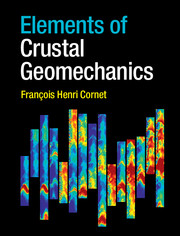Book contents
- Frontmatter
- Epigraph
- Contents
- Preface
- 1 Geomaterials and crustal geomechanics
- 2 Elements of rheology
- 3 Forces and stresses
- 4 Elements of kinematics
- 5 Elements of linear elasticity
- 6 From continuum mechanics to fluid mechanics
- 7 Elements of linear fracture mechanics
- 8 Laboratory investigations on geomaterials under compression 183
- 9 Homogenized geomaterials
- 10 Fractures and faults
- 11 Elements of seismology
- 12 Elements of solid–fluid interactions
- 13 Methods for stress field evaluation from in situ observations
- 14 Elements of stress fields and crustal rheology
- Appendix Elements of tensors in rectangular coordinates
- References
- Index
11 - Elements of seismology
Published online by Cambridge University Press: 05 April 2015
- Frontmatter
- Epigraph
- Contents
- Preface
- 1 Geomaterials and crustal geomechanics
- 2 Elements of rheology
- 3 Forces and stresses
- 4 Elements of kinematics
- 5 Elements of linear elasticity
- 6 From continuum mechanics to fluid mechanics
- 7 Elements of linear fracture mechanics
- 8 Laboratory investigations on geomaterials under compression 183
- 9 Homogenized geomaterials
- 10 Fractures and faults
- 11 Elements of seismology
- 12 Elements of solid–fluid interactions
- 13 Methods for stress field evaluation from in situ observations
- 14 Elements of stress fields and crustal rheology
- Appendix Elements of tensors in rectangular coordinates
- References
- Index
Summary
We saw in section 10.1.2 that slip on pre-existing fractures may be characterized by rate and state friction laws which imply that slip may be stable or unstable, depending on the loading conditions and material properties. Further, we saw in section 10.3 that unstable slip associated with fault activity may lead to earthquakes of very variable sizes.
In section 8.1.4 we discussed how acoustic emissions are generally observed in rock samples loaded under compression. These high-frequency signals (the frequencies are generally larger than 100 000 Hz) are generated by local instabilities often associated with microcrack growth; these instabilities, depending on the loading conditions, may remain localized or may lead progressively to the complete failure of the rock specimen in a stable or unstable manner.
All these instabilities generate mechanical waves that propagate through the medium surrounding the source. It is important to determine how instabilities start, grow and stop and how this process is related to the associated mechanical wave field.
The object of seismology is to better understand the sources of mechanical waves in geomaterials and to investigate the propagation of these waves through the earth. However, although there is no theoretical restriction on the frequency range of interest, traditionally signals of seismological interest have frequencies ranging from a few fractions of a millihertz to a few tens of hertz, for crustal seismology, or kilohertz for the seismicity induced by human activity (i.e. mining and reservoir engineering). Longer periods are usually investigated in geodetics and higher frequencies in rock physics.
Because wave propagation depends on the mechanical characteristics of the material through which the waves propagate, the analysis of seismic waves may be used to investigate the various structural elements that have influenced the wave train on its travel from the source to the receiver. For example, analysis of the seismic signals generated by large earthquakes has helped refine our understanding of the deeper structure of the earth. Analysis of the mechanical waves observed in other planets, and even stars, is one of the few means available to understand the structure of these celestial objects.
- Type
- Chapter
- Information
- Elements of Crustal Geomechanics , pp. 283 - 321Publisher: Cambridge University PressPrint publication year: 2015



